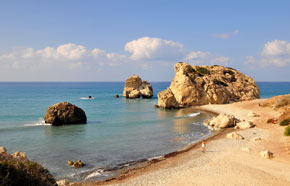





Nearby Attractions
 |
Pissouri Village & Bay
In Pissouri there are several shops, and many tavernas, restaurants and bars serving food and drink of exceptional quality. Local products nowadays are tabled grapes, wine, potatoes and other citrus fruits. The Church of Apostle Andrea was builtin Gothic style, with voluntary work by the good-willing residents of the community in 1883. The place that it is built was used as the village cemetery up to 1912. Other chapels are: Saint George, Prophet Elias, Saint Alexandros, Saint Mauritius, Saint Spyridonas.
|
 |
Pafos Medieval Fort (Kato Pafos near harbour) Originally a Byzantine fort built to protect the harbour, it was rebuilt by the Lusignans in the 13th century, dismantled by the Venetians in 1570 and rebuilt by the Ottomans after they captured the island in the 16th century.The area in front of the castle is used for summer cultural events. |
 |
Roman Mosaics (Kato Pafos near harbour) The mosaic floors are considered among the finest in the Eastern Mediterranean. They mostly depict scenes from Greek mythology. |
 |
Tombs of the Kings The Tombs of the Kings were built between the 3rd Century B.C. and the 3rd Century A.D. They are carved out of solid rock with some being decorated with Doric Pillars. High officials and rich citizens of the Ptolemaic administration rather than Kings were buried here, but the magnificence of the tombs gave the locality its name. |
 |
Aphrodite´s Birth Place According to legend, Aphrodite, goddess of love and beauty, rose from the waves in this strikingly beautiful spot. The Greek name, Petra tou Romiou, “The Rock of the Greek”, is associated with the legendary frontier-guard of Byzantine times, Digenis Akritas, who kept the marauding Saracens at bay with amazing strength. It is said that he heaved this large rock into the sea destroying the enemy’s ship. |
 |
Kolossi Castle
Kolossi Castle is 14 kilometres (9 mi) east of Ampelokipi Holiday Apartments. It held great strategic importance and contained facilities for the production of sugar, one of Cyprus's main exports in the Middle Ages. The original castle was possibly built in 1210 by the Frankish military, when the land of Kolossi was given by King Hugh III to the Knights of the Order of St John of Jerusalem (Hospitallers). The present castle was built in 1454 by the Hospitallers. |


